BA Business Economics: UK Corporate Tax Reform and Business Impact
VerifiedAdded on 2022/12/12
|8
|2547
|263
Report
AI Summary
This economics report analyzes the impact of the UK government's corporate tax reforms on businesses and the overall UK economy. The report begins by defining corporation tax and its historical context, noting the reduction in the main rate of corporation tax from 19% to 18%. The report then explores both the positive and negative impacts of this tax reduction. Positive impacts include increased research and development credits, the patent box initiative to boost innovation, and favorable international taxation policies. Negative impacts include potential effects on investment, revenue, employment, and the multiplier effect. The report further discusses productivity, wage effects, and price changes. The author concludes that the corporation tax regime in the United Kingdom is expected to have more positive impacts compared to negative ones, particularly through research and development and innovation. The report utilizes economic theory, citing various studies and research papers to support the arguments. The overall objective is to assess the UK government's policy and its effect on the UK economy.
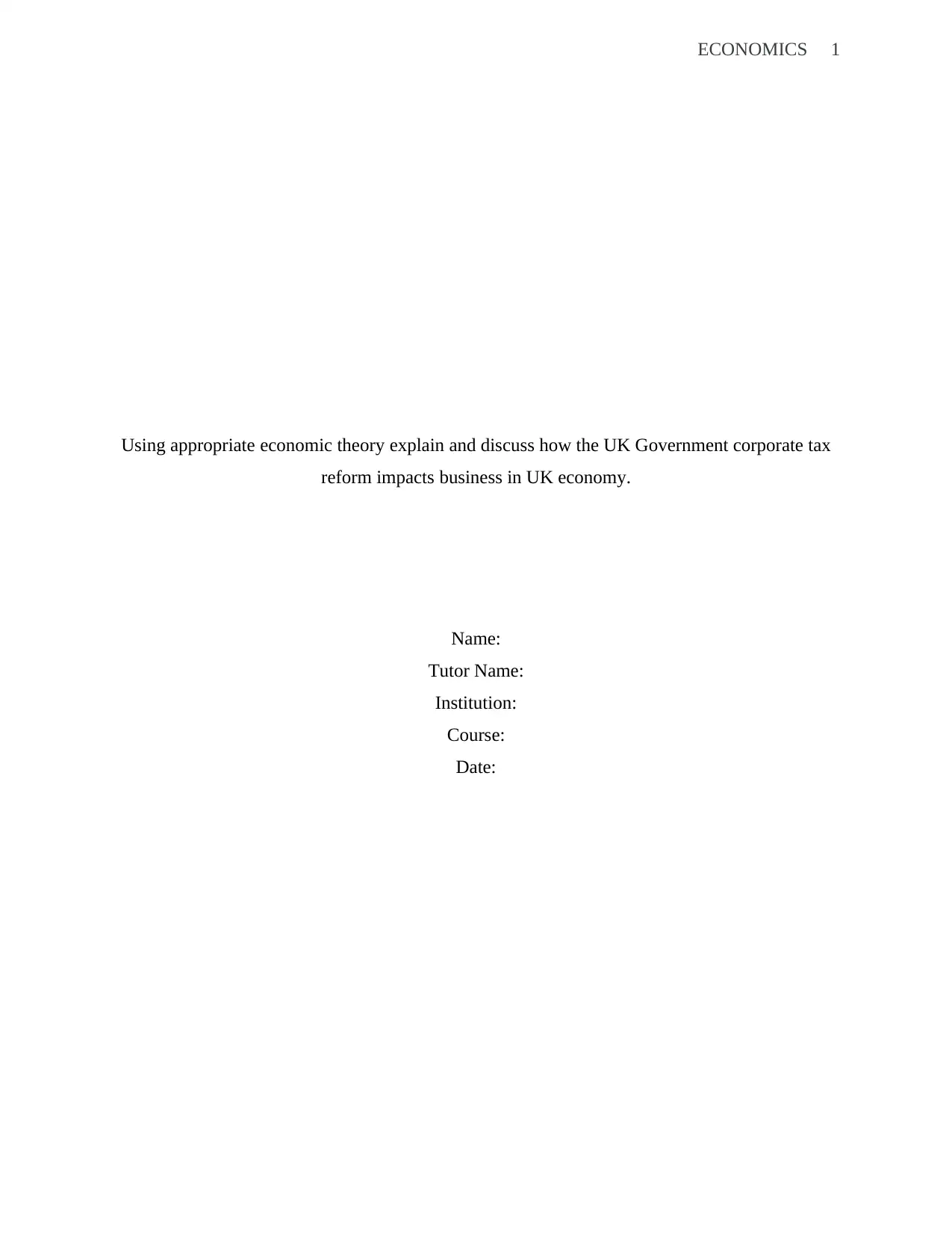
ECONOMICS 1
Using appropriate economic theory explain and discuss how the UK Government corporate tax
reform impacts business in UK economy.
Name:
Tutor Name:
Institution:
Course:
Date:
Using appropriate economic theory explain and discuss how the UK Government corporate tax
reform impacts business in UK economy.
Name:
Tutor Name:
Institution:
Course:
Date:
Paraphrase This Document
Need a fresh take? Get an instant paraphrase of this document with our AI Paraphraser
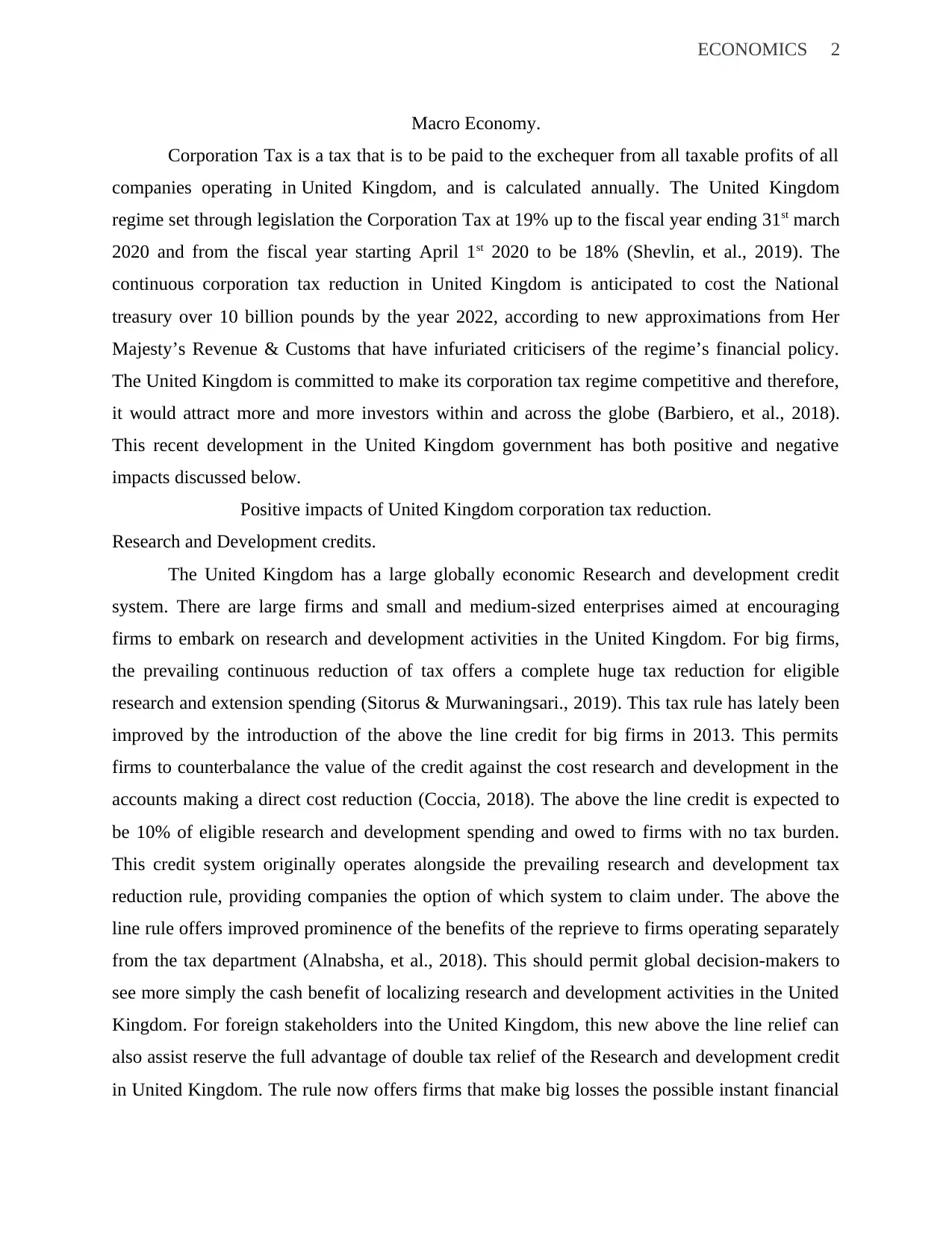
ECONOMICS 2
Macro Economy.
Corporation Tax is a tax that is to be paid to the exchequer from all taxable profits of all
companies operating in United Kingdom, and is calculated annually. The United Kingdom
regime set through legislation the Corporation Tax at 19% up to the fiscal year ending 31st march
2020 and from the fiscal year starting April 1st 2020 to be 18% (Shevlin, et al., 2019). The
continuous corporation tax reduction in United Kingdom is anticipated to cost the National
treasury over 10 billion pounds by the year 2022, according to new approximations from Her
Majesty’s Revenue & Customs that have infuriated criticisers of the regime’s financial policy.
The United Kingdom is committed to make its corporation tax regime competitive and therefore,
it would attract more and more investors within and across the globe (Barbiero, et al., 2018).
This recent development in the United Kingdom government has both positive and negative
impacts discussed below.
Positive impacts of United Kingdom corporation tax reduction.
Research and Development credits.
The United Kingdom has a large globally economic Research and development credit
system. There are large firms and small and medium-sized enterprises aimed at encouraging
firms to embark on research and development activities in the United Kingdom. For big firms,
the prevailing continuous reduction of tax offers a complete huge tax reduction for eligible
research and extension spending (Sitorus & Murwaningsari., 2019). This tax rule has lately been
improved by the introduction of the above the line credit for big firms in 2013. This permits
firms to counterbalance the value of the credit against the cost research and development in the
accounts making a direct cost reduction (Coccia, 2018). The above the line credit is expected to
be 10% of eligible research and development spending and owed to firms with no tax burden.
This credit system originally operates alongside the prevailing research and development tax
reduction rule, providing companies the option of which system to claim under. The above the
line rule offers improved prominence of the benefits of the reprieve to firms operating separately
from the tax department (Alnabsha, et al., 2018). This should permit global decision-makers to
see more simply the cash benefit of localizing research and development activities in the United
Kingdom. For foreign stakeholders into the United Kingdom, this new above the line relief can
also assist reserve the full advantage of double tax relief of the Research and development credit
in United Kingdom. The rule now offers firms that make big losses the possible instant financial
Macro Economy.
Corporation Tax is a tax that is to be paid to the exchequer from all taxable profits of all
companies operating in United Kingdom, and is calculated annually. The United Kingdom
regime set through legislation the Corporation Tax at 19% up to the fiscal year ending 31st march
2020 and from the fiscal year starting April 1st 2020 to be 18% (Shevlin, et al., 2019). The
continuous corporation tax reduction in United Kingdom is anticipated to cost the National
treasury over 10 billion pounds by the year 2022, according to new approximations from Her
Majesty’s Revenue & Customs that have infuriated criticisers of the regime’s financial policy.
The United Kingdom is committed to make its corporation tax regime competitive and therefore,
it would attract more and more investors within and across the globe (Barbiero, et al., 2018).
This recent development in the United Kingdom government has both positive and negative
impacts discussed below.
Positive impacts of United Kingdom corporation tax reduction.
Research and Development credits.
The United Kingdom has a large globally economic Research and development credit
system. There are large firms and small and medium-sized enterprises aimed at encouraging
firms to embark on research and development activities in the United Kingdom. For big firms,
the prevailing continuous reduction of tax offers a complete huge tax reduction for eligible
research and extension spending (Sitorus & Murwaningsari., 2019). This tax rule has lately been
improved by the introduction of the above the line credit for big firms in 2013. This permits
firms to counterbalance the value of the credit against the cost research and development in the
accounts making a direct cost reduction (Coccia, 2018). The above the line credit is expected to
be 10% of eligible research and development spending and owed to firms with no tax burden.
This credit system originally operates alongside the prevailing research and development tax
reduction rule, providing companies the option of which system to claim under. The above the
line rule offers improved prominence of the benefits of the reprieve to firms operating separately
from the tax department (Alnabsha, et al., 2018). This should permit global decision-makers to
see more simply the cash benefit of localizing research and development activities in the United
Kingdom. For foreign stakeholders into the United Kingdom, this new above the line relief can
also assist reserve the full advantage of double tax relief of the Research and development credit
in United Kingdom. The rule now offers firms that make big losses the possible instant financial
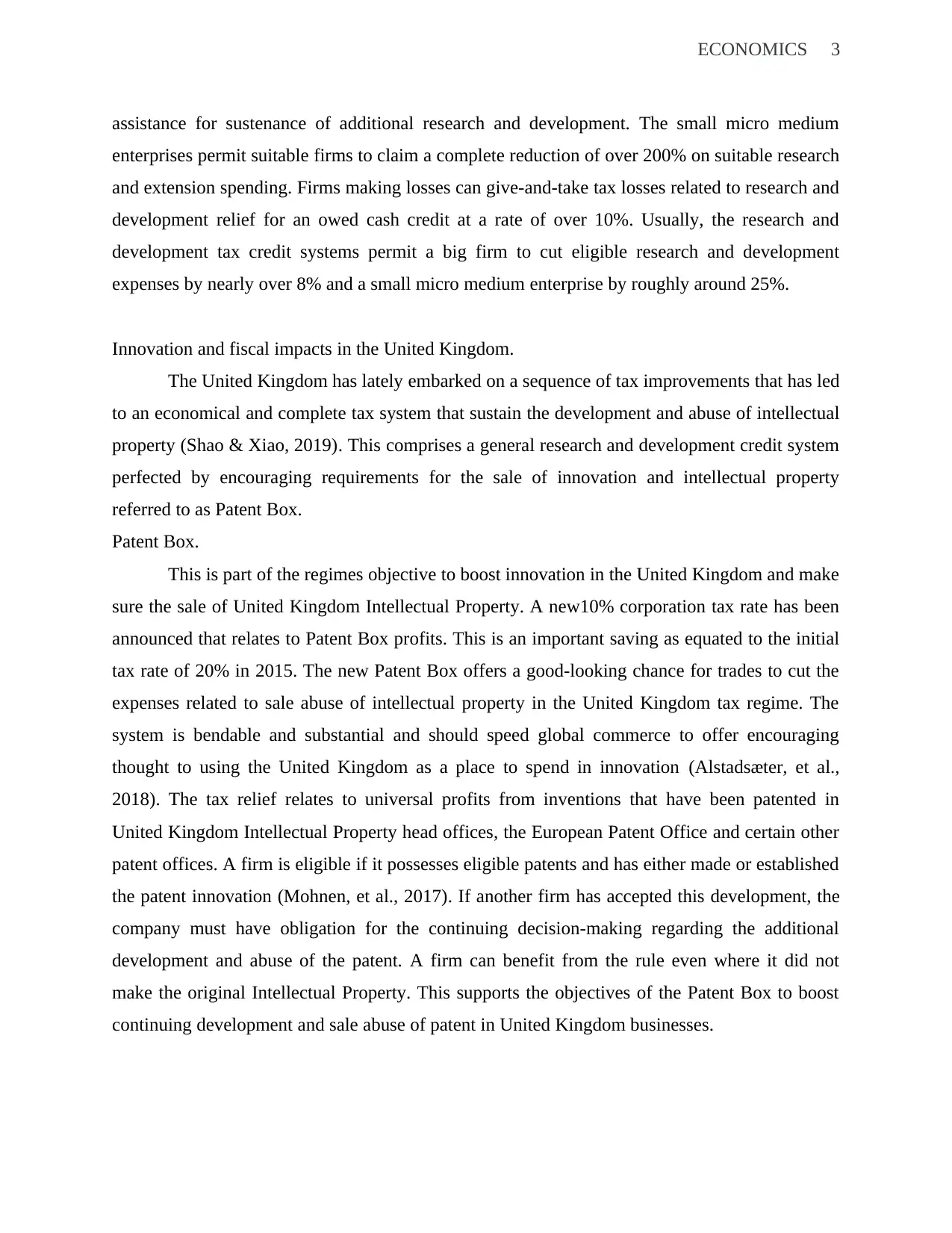
ECONOMICS 3
assistance for sustenance of additional research and development. The small micro medium
enterprises permit suitable firms to claim a complete reduction of over 200% on suitable research
and extension spending. Firms making losses can give-and-take tax losses related to research and
development relief for an owed cash credit at a rate of over 10%. Usually, the research and
development tax credit systems permit a big firm to cut eligible research and development
expenses by nearly over 8% and a small micro medium enterprise by roughly around 25%.
Innovation and fiscal impacts in the United Kingdom.
The United Kingdom has lately embarked on a sequence of tax improvements that has led
to an economical and complete tax system that sustain the development and abuse of intellectual
property (Shao & Xiao, 2019). This comprises a general research and development credit system
perfected by encouraging requirements for the sale of innovation and intellectual property
referred to as Patent Box.
Patent Box.
This is part of the regimes objective to boost innovation in the United Kingdom and make
sure the sale of United Kingdom Intellectual Property. A new10% corporation tax rate has been
announced that relates to Patent Box profits. This is an important saving as equated to the initial
tax rate of 20% in 2015. The new Patent Box offers a good-looking chance for trades to cut the
expenses related to sale abuse of intellectual property in the United Kingdom tax regime. The
system is bendable and substantial and should speed global commerce to offer encouraging
thought to using the United Kingdom as a place to spend in innovation (Alstadsæter, et al.,
2018). The tax relief relates to universal profits from inventions that have been patented in
United Kingdom Intellectual Property head offices, the European Patent Office and certain other
patent offices. A firm is eligible if it possesses eligible patents and has either made or established
the patent innovation (Mohnen, et al., 2017). If another firm has accepted this development, the
company must have obligation for the continuing decision-making regarding the additional
development and abuse of the patent. A firm can benefit from the rule even where it did not
make the original Intellectual Property. This supports the objectives of the Patent Box to boost
continuing development and sale abuse of patent in United Kingdom businesses.
assistance for sustenance of additional research and development. The small micro medium
enterprises permit suitable firms to claim a complete reduction of over 200% on suitable research
and extension spending. Firms making losses can give-and-take tax losses related to research and
development relief for an owed cash credit at a rate of over 10%. Usually, the research and
development tax credit systems permit a big firm to cut eligible research and development
expenses by nearly over 8% and a small micro medium enterprise by roughly around 25%.
Innovation and fiscal impacts in the United Kingdom.
The United Kingdom has lately embarked on a sequence of tax improvements that has led
to an economical and complete tax system that sustain the development and abuse of intellectual
property (Shao & Xiao, 2019). This comprises a general research and development credit system
perfected by encouraging requirements for the sale of innovation and intellectual property
referred to as Patent Box.
Patent Box.
This is part of the regimes objective to boost innovation in the United Kingdom and make
sure the sale of United Kingdom Intellectual Property. A new10% corporation tax rate has been
announced that relates to Patent Box profits. This is an important saving as equated to the initial
tax rate of 20% in 2015. The new Patent Box offers a good-looking chance for trades to cut the
expenses related to sale abuse of intellectual property in the United Kingdom tax regime. The
system is bendable and substantial and should speed global commerce to offer encouraging
thought to using the United Kingdom as a place to spend in innovation (Alstadsæter, et al.,
2018). The tax relief relates to universal profits from inventions that have been patented in
United Kingdom Intellectual Property head offices, the European Patent Office and certain other
patent offices. A firm is eligible if it possesses eligible patents and has either made or established
the patent innovation (Mohnen, et al., 2017). If another firm has accepted this development, the
company must have obligation for the continuing decision-making regarding the additional
development and abuse of the patent. A firm can benefit from the rule even where it did not
make the original Intellectual Property. This supports the objectives of the Patent Box to boost
continuing development and sale abuse of patent in United Kingdom businesses.
⊘ This is a preview!⊘
Do you want full access?
Subscribe today to unlock all pages.

Trusted by 1+ million students worldwide
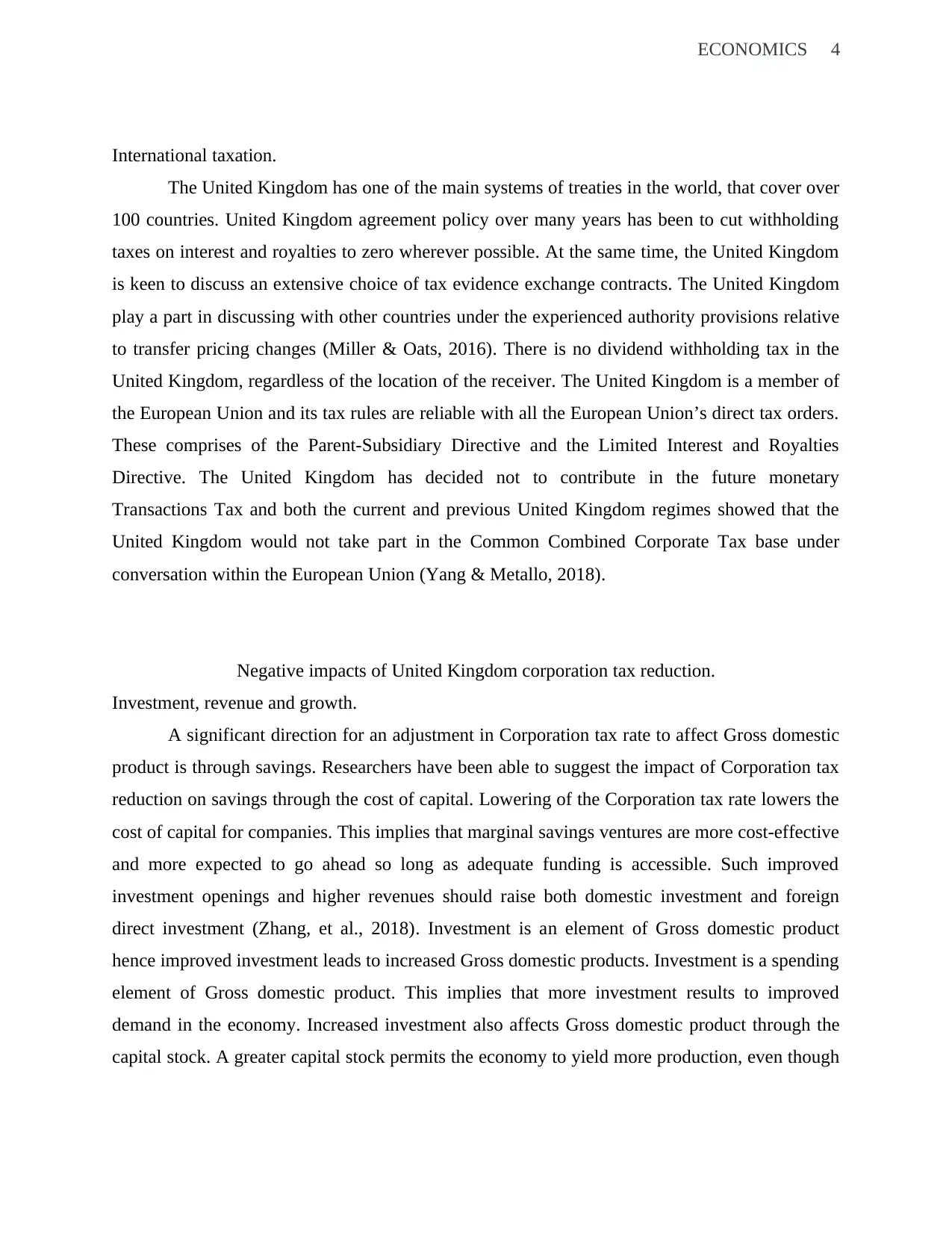
ECONOMICS 4
International taxation.
The United Kingdom has one of the main systems of treaties in the world, that cover over
100 countries. United Kingdom agreement policy over many years has been to cut withholding
taxes on interest and royalties to zero wherever possible. At the same time, the United Kingdom
is keen to discuss an extensive choice of tax evidence exchange contracts. The United Kingdom
play a part in discussing with other countries under the experienced authority provisions relative
to transfer pricing changes (Miller & Oats, 2016). There is no dividend withholding tax in the
United Kingdom, regardless of the location of the receiver. The United Kingdom is a member of
the European Union and its tax rules are reliable with all the European Union’s direct tax orders.
These comprises of the Parent-Subsidiary Directive and the Limited Interest and Royalties
Directive. The United Kingdom has decided not to contribute in the future monetary
Transactions Tax and both the current and previous United Kingdom regimes showed that the
United Kingdom would not take part in the Common Combined Corporate Tax base under
conversation within the European Union (Yang & Metallo, 2018).
Negative impacts of United Kingdom corporation tax reduction.
Investment, revenue and growth.
A significant direction for an adjustment in Corporation tax rate to affect Gross domestic
product is through savings. Researchers have been able to suggest the impact of Corporation tax
reduction on savings through the cost of capital. Lowering of the Corporation tax rate lowers the
cost of capital for companies. This implies that marginal savings ventures are more cost-effective
and more expected to go ahead so long as adequate funding is accessible. Such improved
investment openings and higher revenues should raise both domestic investment and foreign
direct investment (Zhang, et al., 2018). Investment is an element of Gross domestic product
hence improved investment leads to increased Gross domestic products. Investment is a spending
element of Gross domestic product. This implies that more investment results to improved
demand in the economy. Increased investment also affects Gross domestic product through the
capital stock. A greater capital stock permits the economy to yield more production, even though
International taxation.
The United Kingdom has one of the main systems of treaties in the world, that cover over
100 countries. United Kingdom agreement policy over many years has been to cut withholding
taxes on interest and royalties to zero wherever possible. At the same time, the United Kingdom
is keen to discuss an extensive choice of tax evidence exchange contracts. The United Kingdom
play a part in discussing with other countries under the experienced authority provisions relative
to transfer pricing changes (Miller & Oats, 2016). There is no dividend withholding tax in the
United Kingdom, regardless of the location of the receiver. The United Kingdom is a member of
the European Union and its tax rules are reliable with all the European Union’s direct tax orders.
These comprises of the Parent-Subsidiary Directive and the Limited Interest and Royalties
Directive. The United Kingdom has decided not to contribute in the future monetary
Transactions Tax and both the current and previous United Kingdom regimes showed that the
United Kingdom would not take part in the Common Combined Corporate Tax base under
conversation within the European Union (Yang & Metallo, 2018).
Negative impacts of United Kingdom corporation tax reduction.
Investment, revenue and growth.
A significant direction for an adjustment in Corporation tax rate to affect Gross domestic
product is through savings. Researchers have been able to suggest the impact of Corporation tax
reduction on savings through the cost of capital. Lowering of the Corporation tax rate lowers the
cost of capital for companies. This implies that marginal savings ventures are more cost-effective
and more expected to go ahead so long as adequate funding is accessible. Such improved
investment openings and higher revenues should raise both domestic investment and foreign
direct investment (Zhang, et al., 2018). Investment is an element of Gross domestic product
hence improved investment leads to increased Gross domestic products. Investment is a spending
element of Gross domestic product. This implies that more investment results to improved
demand in the economy. Increased investment also affects Gross domestic product through the
capital stock. A greater capital stock permits the economy to yield more production, even though
Paraphrase This Document
Need a fresh take? Get an instant paraphrase of this document with our AI Paraphraser
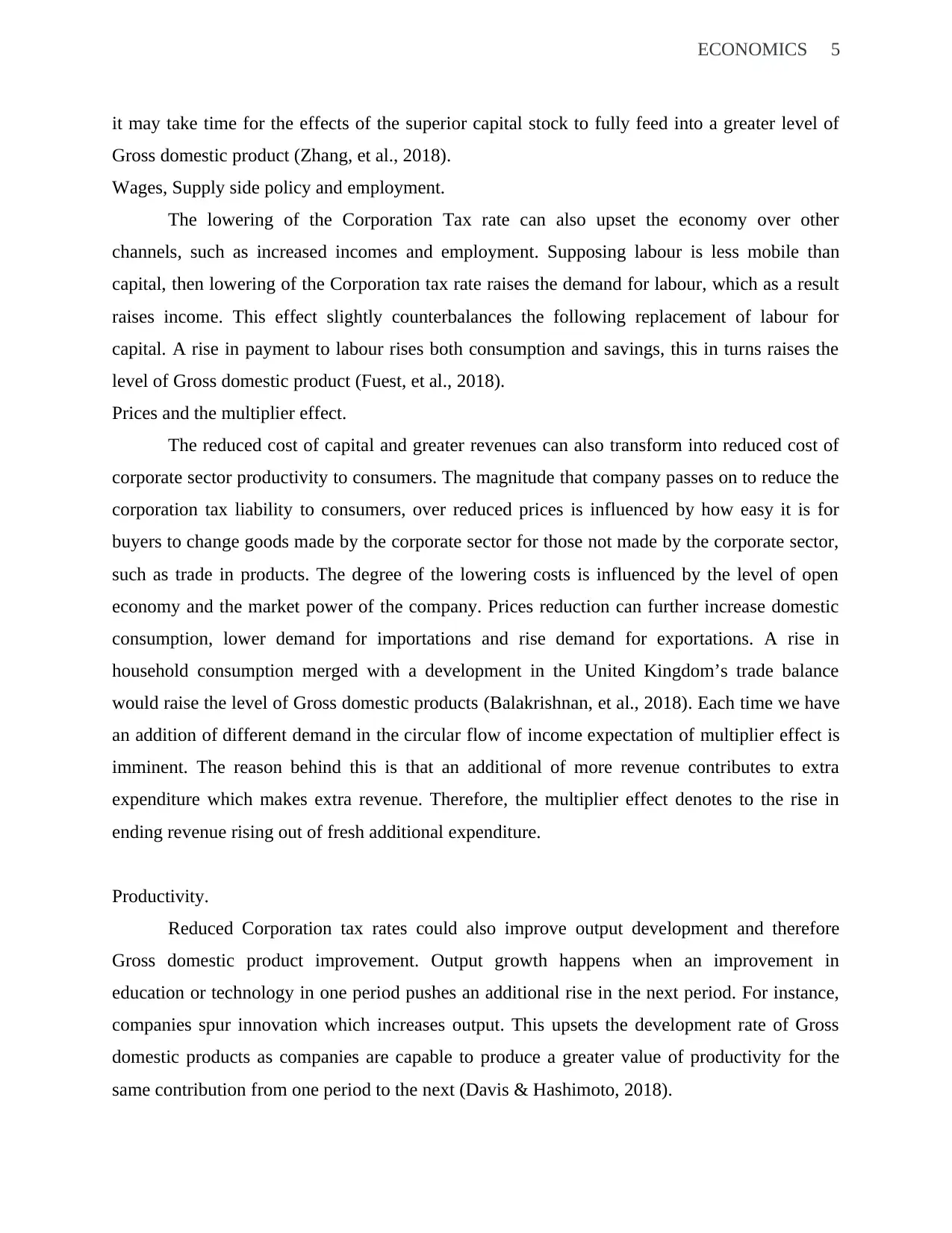
ECONOMICS 5
it may take time for the effects of the superior capital stock to fully feed into a greater level of
Gross domestic product (Zhang, et al., 2018).
Wages, Supply side policy and employment.
The lowering of the Corporation Tax rate can also upset the economy over other
channels, such as increased incomes and employment. Supposing labour is less mobile than
capital, then lowering of the Corporation tax rate raises the demand for labour, which as a result
raises income. This effect slightly counterbalances the following replacement of labour for
capital. A rise in payment to labour rises both consumption and savings, this in turns raises the
level of Gross domestic product (Fuest, et al., 2018).
Prices and the multiplier effect.
The reduced cost of capital and greater revenues can also transform into reduced cost of
corporate sector productivity to consumers. The magnitude that company passes on to reduce the
corporation tax liability to consumers, over reduced prices is influenced by how easy it is for
buyers to change goods made by the corporate sector for those not made by the corporate sector,
such as trade in products. The degree of the lowering costs is influenced by the level of open
economy and the market power of the company. Prices reduction can further increase domestic
consumption, lower demand for importations and rise demand for exportations. A rise in
household consumption merged with a development in the United Kingdom’s trade balance
would raise the level of Gross domestic products (Balakrishnan, et al., 2018). Each time we have
an addition of different demand in the circular flow of income expectation of multiplier effect is
imminent. The reason behind this is that an additional of more revenue contributes to extra
expenditure which makes extra revenue. Therefore, the multiplier effect denotes to the rise in
ending revenue rising out of fresh additional expenditure.
Productivity.
Reduced Corporation tax rates could also improve output development and therefore
Gross domestic product improvement. Output growth happens when an improvement in
education or technology in one period pushes an additional rise in the next period. For instance,
companies spur innovation which increases output. This upsets the development rate of Gross
domestic products as companies are capable to produce a greater value of productivity for the
same contribution from one period to the next (Davis & Hashimoto, 2018).
it may take time for the effects of the superior capital stock to fully feed into a greater level of
Gross domestic product (Zhang, et al., 2018).
Wages, Supply side policy and employment.
The lowering of the Corporation Tax rate can also upset the economy over other
channels, such as increased incomes and employment. Supposing labour is less mobile than
capital, then lowering of the Corporation tax rate raises the demand for labour, which as a result
raises income. This effect slightly counterbalances the following replacement of labour for
capital. A rise in payment to labour rises both consumption and savings, this in turns raises the
level of Gross domestic product (Fuest, et al., 2018).
Prices and the multiplier effect.
The reduced cost of capital and greater revenues can also transform into reduced cost of
corporate sector productivity to consumers. The magnitude that company passes on to reduce the
corporation tax liability to consumers, over reduced prices is influenced by how easy it is for
buyers to change goods made by the corporate sector for those not made by the corporate sector,
such as trade in products. The degree of the lowering costs is influenced by the level of open
economy and the market power of the company. Prices reduction can further increase domestic
consumption, lower demand for importations and rise demand for exportations. A rise in
household consumption merged with a development in the United Kingdom’s trade balance
would raise the level of Gross domestic products (Balakrishnan, et al., 2018). Each time we have
an addition of different demand in the circular flow of income expectation of multiplier effect is
imminent. The reason behind this is that an additional of more revenue contributes to extra
expenditure which makes extra revenue. Therefore, the multiplier effect denotes to the rise in
ending revenue rising out of fresh additional expenditure.
Productivity.
Reduced Corporation tax rates could also improve output development and therefore
Gross domestic product improvement. Output growth happens when an improvement in
education or technology in one period pushes an additional rise in the next period. For instance,
companies spur innovation which increases output. This upsets the development rate of Gross
domestic products as companies are capable to produce a greater value of productivity for the
same contribution from one period to the next (Davis & Hashimoto, 2018).
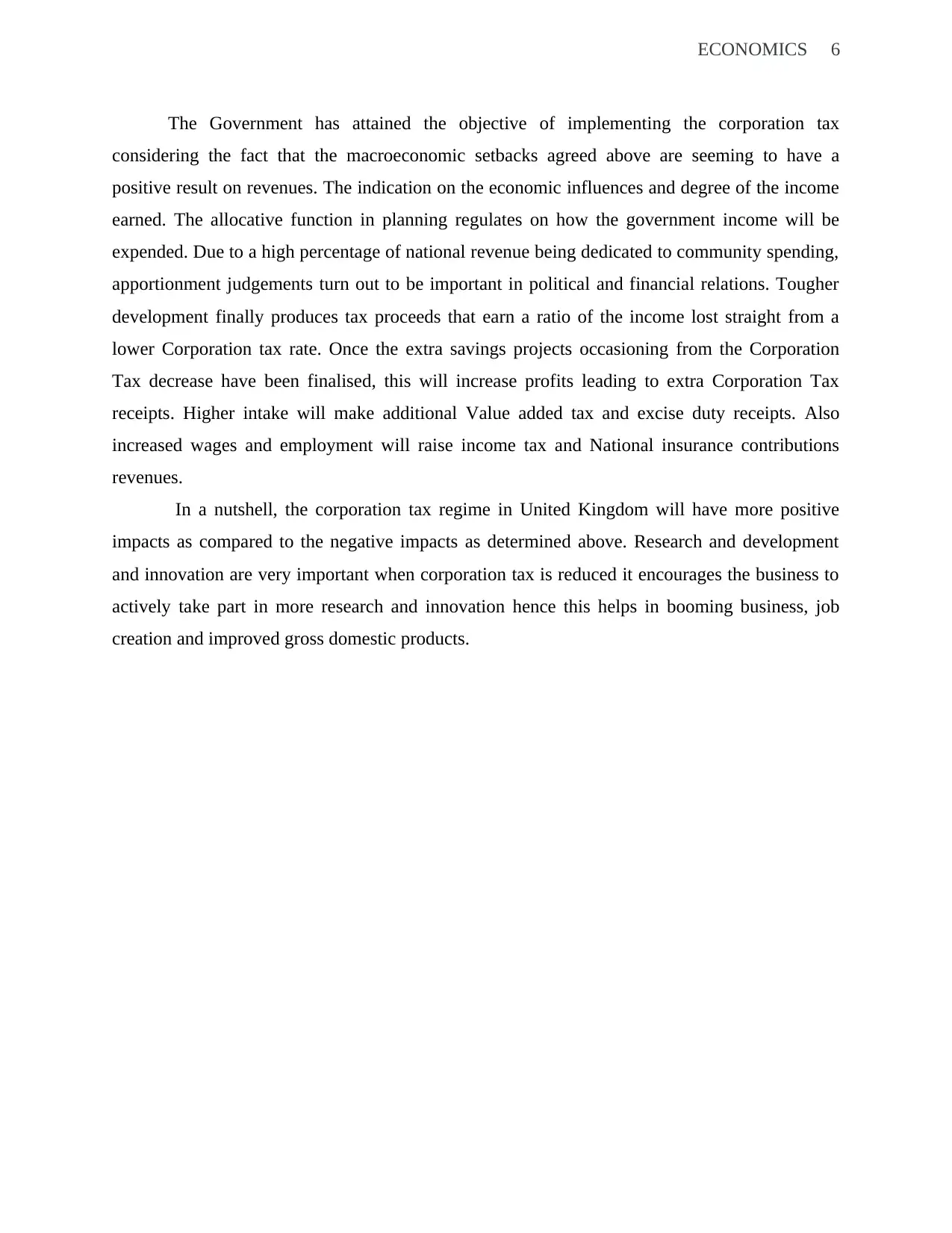
ECONOMICS 6
The Government has attained the objective of implementing the corporation tax
considering the fact that the macroeconomic setbacks agreed above are seeming to have a
positive result on revenues. The indication on the economic influences and degree of the income
earned. The allocative function in planning regulates on how the government income will be
expended. Due to a high percentage of national revenue being dedicated to community spending,
apportionment judgements turn out to be important in political and financial relations. Tougher
development finally produces tax proceeds that earn a ratio of the income lost straight from a
lower Corporation tax rate. Once the extra savings projects occasioning from the Corporation
Tax decrease have been finalised, this will increase profits leading to extra Corporation Tax
receipts. Higher intake will make additional Value added tax and excise duty receipts. Also
increased wages and employment will raise income tax and National insurance contributions
revenues.
In a nutshell, the corporation tax regime in United Kingdom will have more positive
impacts as compared to the negative impacts as determined above. Research and development
and innovation are very important when corporation tax is reduced it encourages the business to
actively take part in more research and innovation hence this helps in booming business, job
creation and improved gross domestic products.
The Government has attained the objective of implementing the corporation tax
considering the fact that the macroeconomic setbacks agreed above are seeming to have a
positive result on revenues. The indication on the economic influences and degree of the income
earned. The allocative function in planning regulates on how the government income will be
expended. Due to a high percentage of national revenue being dedicated to community spending,
apportionment judgements turn out to be important in political and financial relations. Tougher
development finally produces tax proceeds that earn a ratio of the income lost straight from a
lower Corporation tax rate. Once the extra savings projects occasioning from the Corporation
Tax decrease have been finalised, this will increase profits leading to extra Corporation Tax
receipts. Higher intake will make additional Value added tax and excise duty receipts. Also
increased wages and employment will raise income tax and National insurance contributions
revenues.
In a nutshell, the corporation tax regime in United Kingdom will have more positive
impacts as compared to the negative impacts as determined above. Research and development
and innovation are very important when corporation tax is reduced it encourages the business to
actively take part in more research and innovation hence this helps in booming business, job
creation and improved gross domestic products.
⊘ This is a preview!⊘
Do you want full access?
Subscribe today to unlock all pages.

Trusted by 1+ million students worldwide
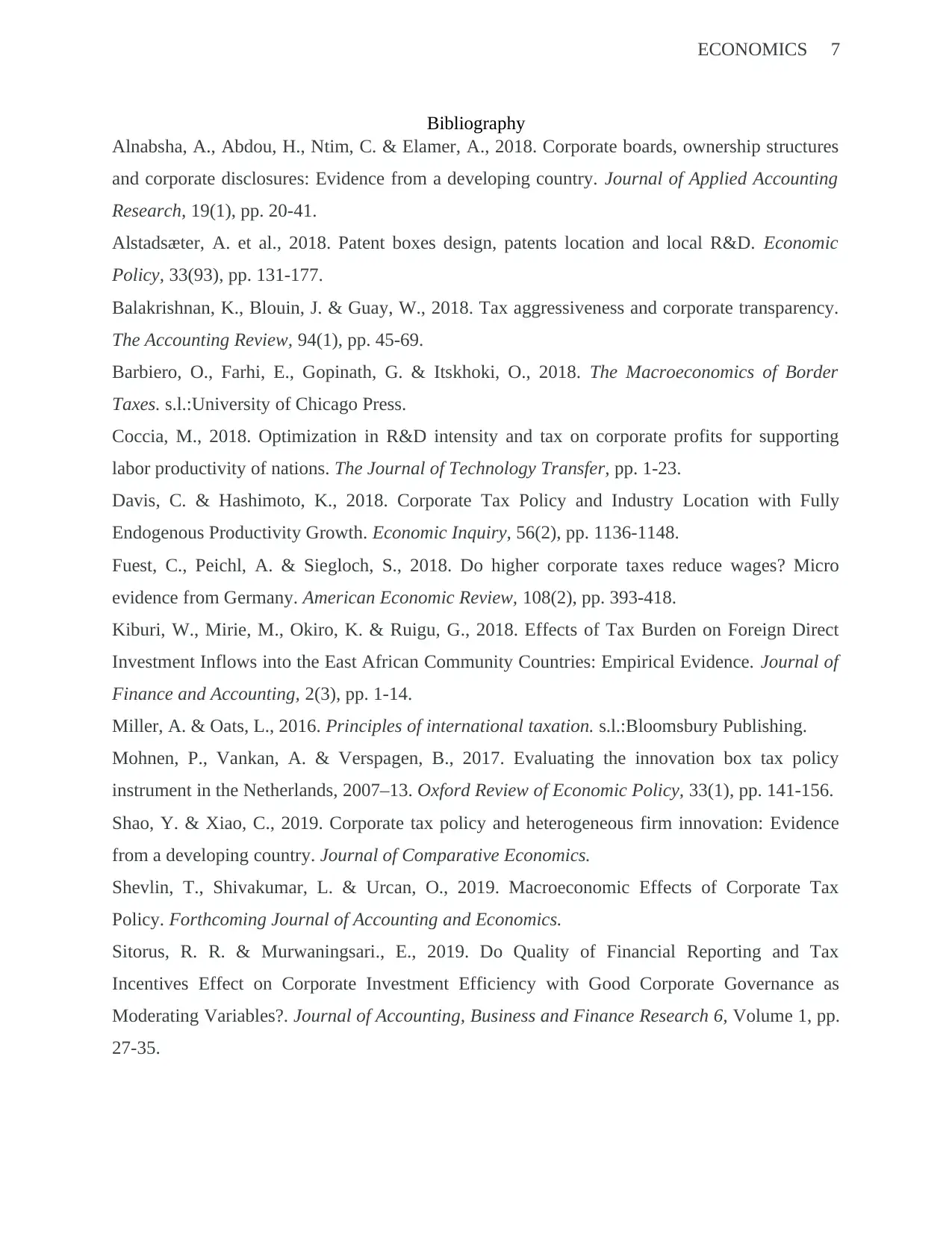
ECONOMICS 7
Bibliography
Alnabsha, A., Abdou, H., Ntim, C. & Elamer, A., 2018. Corporate boards, ownership structures
and corporate disclosures: Evidence from a developing country. Journal of Applied Accounting
Research, 19(1), pp. 20-41.
Alstadsæter, A. et al., 2018. Patent boxes design, patents location and local R&D. Economic
Policy, 33(93), pp. 131-177.
Balakrishnan, K., Blouin, J. & Guay, W., 2018. Tax aggressiveness and corporate transparency.
The Accounting Review, 94(1), pp. 45-69.
Barbiero, O., Farhi, E., Gopinath, G. & Itskhoki, O., 2018. The Macroeconomics of Border
Taxes. s.l.:University of Chicago Press.
Coccia, M., 2018. Optimization in R&D intensity and tax on corporate profits for supporting
labor productivity of nations. The Journal of Technology Transfer, pp. 1-23.
Davis, C. & Hashimoto, K., 2018. Corporate Tax Policy and Industry Location with Fully
Endogenous Productivity Growth. Economic Inquiry, 56(2), pp. 1136-1148.
Fuest, C., Peichl, A. & Siegloch, S., 2018. Do higher corporate taxes reduce wages? Micro
evidence from Germany. American Economic Review, 108(2), pp. 393-418.
Kiburi, W., Mirie, M., Okiro, K. & Ruigu, G., 2018. Effects of Tax Burden on Foreign Direct
Investment Inflows into the East African Community Countries: Empirical Evidence. Journal of
Finance and Accounting, 2(3), pp. 1-14.
Miller, A. & Oats, L., 2016. Principles of international taxation. s.l.:Bloomsbury Publishing.
Mohnen, P., Vankan, A. & Verspagen, B., 2017. Evaluating the innovation box tax policy
instrument in the Netherlands, 2007–13. Oxford Review of Economic Policy, 33(1), pp. 141-156.
Shao, Y. & Xiao, C., 2019. Corporate tax policy and heterogeneous firm innovation: Evidence
from a developing country. Journal of Comparative Economics.
Shevlin, T., Shivakumar, L. & Urcan, O., 2019. Macroeconomic Effects of Corporate Tax
Policy. Forthcoming Journal of Accounting and Economics.
Sitorus, R. R. & Murwaningsari., E., 2019. Do Quality of Financial Reporting and Tax
Incentives Effect on Corporate Investment Efficiency with Good Corporate Governance as
Moderating Variables?. Journal of Accounting, Business and Finance Research 6, Volume 1, pp.
27-35.
Bibliography
Alnabsha, A., Abdou, H., Ntim, C. & Elamer, A., 2018. Corporate boards, ownership structures
and corporate disclosures: Evidence from a developing country. Journal of Applied Accounting
Research, 19(1), pp. 20-41.
Alstadsæter, A. et al., 2018. Patent boxes design, patents location and local R&D. Economic
Policy, 33(93), pp. 131-177.
Balakrishnan, K., Blouin, J. & Guay, W., 2018. Tax aggressiveness and corporate transparency.
The Accounting Review, 94(1), pp. 45-69.
Barbiero, O., Farhi, E., Gopinath, G. & Itskhoki, O., 2018. The Macroeconomics of Border
Taxes. s.l.:University of Chicago Press.
Coccia, M., 2018. Optimization in R&D intensity and tax on corporate profits for supporting
labor productivity of nations. The Journal of Technology Transfer, pp. 1-23.
Davis, C. & Hashimoto, K., 2018. Corporate Tax Policy and Industry Location with Fully
Endogenous Productivity Growth. Economic Inquiry, 56(2), pp. 1136-1148.
Fuest, C., Peichl, A. & Siegloch, S., 2018. Do higher corporate taxes reduce wages? Micro
evidence from Germany. American Economic Review, 108(2), pp. 393-418.
Kiburi, W., Mirie, M., Okiro, K. & Ruigu, G., 2018. Effects of Tax Burden on Foreign Direct
Investment Inflows into the East African Community Countries: Empirical Evidence. Journal of
Finance and Accounting, 2(3), pp. 1-14.
Miller, A. & Oats, L., 2016. Principles of international taxation. s.l.:Bloomsbury Publishing.
Mohnen, P., Vankan, A. & Verspagen, B., 2017. Evaluating the innovation box tax policy
instrument in the Netherlands, 2007–13. Oxford Review of Economic Policy, 33(1), pp. 141-156.
Shao, Y. & Xiao, C., 2019. Corporate tax policy and heterogeneous firm innovation: Evidence
from a developing country. Journal of Comparative Economics.
Shevlin, T., Shivakumar, L. & Urcan, O., 2019. Macroeconomic Effects of Corporate Tax
Policy. Forthcoming Journal of Accounting and Economics.
Sitorus, R. R. & Murwaningsari., E., 2019. Do Quality of Financial Reporting and Tax
Incentives Effect on Corporate Investment Efficiency with Good Corporate Governance as
Moderating Variables?. Journal of Accounting, Business and Finance Research 6, Volume 1, pp.
27-35.
Paraphrase This Document
Need a fresh take? Get an instant paraphrase of this document with our AI Paraphraser

ECONOMICS 8
Yang, J. & Metallo, V., 2018. The Emerging International Taxation Problems. International
Journal of Financial Studies, 6(1), p. 6.
Zhang, L., Chen, Y. & He, Z., 2018. The effect of investment tax incentives: evidence from
China’s value-added tax reform. International Tax and Public Finance, 25(4), pp. 913-945.
Yang, J. & Metallo, V., 2018. The Emerging International Taxation Problems. International
Journal of Financial Studies, 6(1), p. 6.
Zhang, L., Chen, Y. & He, Z., 2018. The effect of investment tax incentives: evidence from
China’s value-added tax reform. International Tax and Public Finance, 25(4), pp. 913-945.
1 out of 8
Your All-in-One AI-Powered Toolkit for Academic Success.
+13062052269
info@desklib.com
Available 24*7 on WhatsApp / Email
![[object Object]](/_next/static/media/star-bottom.7253800d.svg)
Unlock your academic potential
Copyright © 2020–2025 A2Z Services. All Rights Reserved. Developed and managed by ZUCOL.